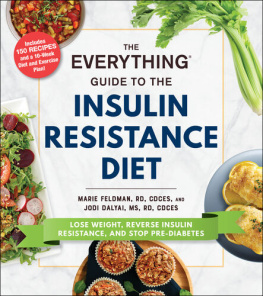The Best of Everything
Diabetes Diet
50 Essential Recipes for Todays Busy Cook
Adams Media, a division of F+W Media, Inc.
Avon, Massachusetts
Contents
Introduction
Whether you have just been diagnosed with diabetes or you have dealt with it for many years, there are steps you can take to manage it effectively. A daily plan for diabetes includes a healthy eating plan, exercise, and possibly medication. Learning more about healthy eating habits and ways to prepare tasty, enjoyable foods can help you start making those changes. As you make small changes to your eating habits, youll soon realize that you can have more control over your diabetes. Work closely with your doctor and dietitian to learn how healthy eating and lifestyle changes can make a big difference in achieving better health and better diabetes control.
Where to Start
Contrary to what you may have heard in the past, there is no strict diet you must follow. You will likely need to make some changes in your lifestyle, and sometimes changes can seem very difficult. It is usually not necessary to totally change everything about the way that you eat. Managing diabetes is more about adopting a healthier lifestyle by making small changes one at a time.
Its very important to avoid skipping meals. Regular meal times help prevent high or low blood sugar readings. When you skip meals, you run the risk of having an unexpected low blood sugar. Skipping meals can also lead to overeating at the next meal, causing a blood sugar high.
The American Association of Diabetes Educators believes that the seven self-care behaviors shown below are effective ways to make positive changes:
- Eat healthy: Make healthy food choices, understand portion sizes, and learn the best times to eat.
- Be active: Include regular activity for overall fitness, weight management, and blood glucose control.
- Monitor: Self-monitor your blood glucose daily to assess how food, physical activity, and medications are working.
- Take medication: Understand how medications work, and when to take them.
- Problem solve: Know how to problem solve. For example, a high or low blood glucose episode requires the ability to make a quick decision about food, activity, or medication.
- Reduce risks: Effective risk-reduction behaviors such as smoking cessation and regular eye exams are examples of self-care that reduce risk of complications.
- Healthy coping: Good coping skills that deal with the challenges of diabetes help you stay motivated to keep your diabetes in control.
There Is No Diabetic Diet
You may think that having diabetes means giving up everything you like to eat, especially carbohydrates. Nothing could be further from the truth! With the help and advice of a registered dietitian, you can adopt healthy eating habits that fit into your lifestyle. Here are several suggestions to get you started on your plan:
- Eat meals at regular intervals.
- Include nutritious snacks in your daily eating plan.
- Try new foods and experiment with whole grains, vegetables, or fruits you have never tried before.
- Work on maintaining good portion control.
- Drink plenty of water every day.
Snacking is a great way to prevent excessive hunger and keep your blood sugar at a healthy level. When chosen wisely, snacks can help you work in the recommended amounts of healthful foods such as fruit or vegetables.
Trying new foods can expand the options of foods in your eating plan. Today there are many more choices of whole or minimally processed foods available to the consumer. Shopping in the produce section of the grocery store or visiting your local farmers market can give you plenty of ideas for including some foods that you may not have used before. Large grocery stores and health food stores carry an array of different whole-grain products that, while not new, may be unfamiliar to you. Using some of the recipes in this book will introduce you to some of the lesser known but healthful whole grains.
Small Steps Every Day = Gradual Lifestyle Changes
Accept that you wont be able to change your eating habits overnight, and adopt the approach of taking small steps every day. Over time, you can make significant changes toward improving your health and reaching consistent near-normal blood glucose levels. Think of changes in your eating habits as goals rather than inflexible rules and regulations. Start by making an honest review of your current eating habits then list what youd like to change or improve. Decide exactly how you will work on each change then select one or two changes to work on at a time. Your dietitian can help you with creative ideas for making changes. Heres an example: If you eat a candy bar as a pick-me-up late in the afternoon, try substituting a small piece of fruit and an ounce of low-fat cheese instead.
Once youve mastered a change, you can move on to something new. Some changes will be easy; others will be difficult or take more time. Start off by making easier changes first, then tackle something that would be very difficult for you.
What Can I Eat?
You may be surprised to learn that your eating plan will have the same foods that everyone else eats, and buying all sorts of specialty or diet foods is usually unnecessary. You may wish to use an artificial sweetener of your choice or certain sugar-free food items; however, this is not essential. You will not have to prepare one meal for yourself and something different for the rest of your household. As you look over the recipes in this cookbook, you will find a few specialty items, but in general the recipes use foods that everyone can eat.
Carbohydrates and Diabetes: Facts You Should Know
Carbohydrates serve as the bodys primary energy source. Simple carbohydrates include all kinds of sugars, sweets, juices, and fruits. Complex carbohydrates include all types of grain products and starchy vegetables such as potatoes or corn. General recommendations for a healthy diet and your diabetes suggest that you get most of your carbohydrates in the form of complex carbohydrates rather than simple sugars. Complex carbohydrates provide an important source of vitamins, minerals, and fiber. Although fruits contain simple sugar, they are also good sources of vitamins, minerals, and fiber, and therefore should be included. To get more fiber, make most of the fruit choices in your eating plan fresh fruit rather than juice.
You may be under the impression that because you have diabetes you must cut out all carbohydrates. This is definitely not the case, and you will be happy to learn there are many carbohydrate food options that you can include in your plan, as long as you choose carbohydrates that have good nutritional value and maintain an appropriate portion size.
Protein: Your Building Blocks to Good Health
Proteins are the building blocks of the body and are used for growth, building, and repair. Animal proteins such as meat, fish, eggs, and milk contain all nine essential amino acids. When all essential amino acids are present in food, it is called a complete protein.
Vegetable proteins are found in nuts, seeds, vegetables, whole grains, and legumes. All vegetable proteins, with the exception of soy, are considered incomplete proteins because one or more of the essential amino acids are missing. Even though a vegetable protein is considered incomplete, it is not considered less nutritious than a complete protein. Incomplete proteins simply need to be combined with other foods to provide the full complement of the nine essential amino acids. For example, combining rice (a grain) with beans (a legume) provides all of the essential amino acids. Combining grains, beans, nuts, vegetables, or seeds in various ways can provide a complete protein.





















